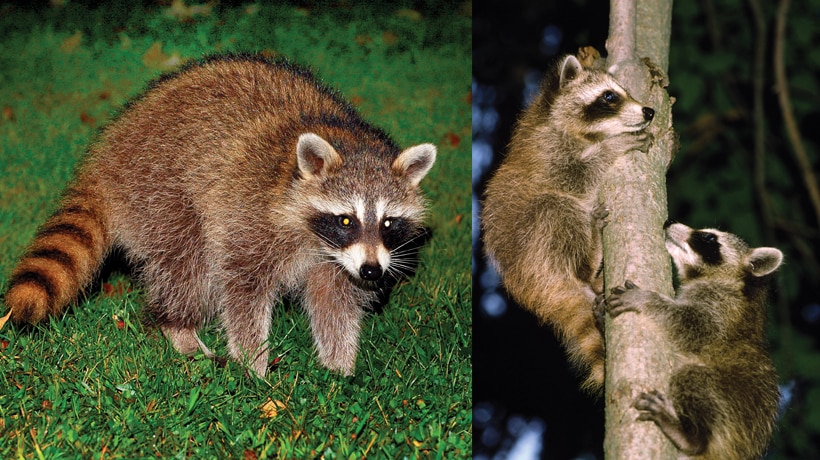Raccoons in Massachusetts
Raccoons are common and abundant throughout Massachusetts, with the exception of Nantucket where they are not found. These highly adaptable mammals thrive in a variety of habitats.
Description
The raccoon, a medium-sized mammal, is easily recognizable, with a bushy tail with alternating black and gray rings, a black face mask outlined in white, and a distinctive humped posture. Raccoons can vary in weight from 12 to 36 pounds, with some exceptionally large individuals reaching 50 pounds. They range in length from 23 to 38 inches, including a 7–16 inch tail. Tracks left by raccoons are easy to identify, as they are quite similar to human handprints and footprints, with five toes and a comparable shape. Raccoons are known for their dexterity. They are capable of turning doorknobs and opening containers.
Life history
The mating season of raccoons generally runs from January to March, although later mating is possible. Raccoons have a 63-day gestation period and will give birth to a litter of 3–7 cubs (4 on average) in April or May. Mother raccoons give birth in dens typically located in a hollow tree, but they may also use brush piles, caves, culverts, woodchuck dens, barns, chimneys, attics, or similar structures. Cubs weigh about 2 ounces at birth, open their eyes at about 3 weeks, and are active by about 7–8 weeks of age. They are weaned by late summer and are independent of their mother after 20 weeks. They become more independent by late fall, but continue to den with the family group, especially during severe winter weather. Cubs disperse in early spring the following year at the age of 9–10 months.
Food, habits, and habitat
Raccoons are highly adaptable and occupy a variety of habitats, including agricultural land, forests, wetlands, and neighborhoods. As omnivorous opportunistic feeders, raccoons will eat whatever is easiest to find and readily available, including insects, crayfish, crabs, mussels, turtles and their eggs, injured waterfowl, and muskrat kits. Raccoons raid bird nests consuming eggs and nestlings, and feed on plant material such as berries, nuts, and seeds. Additionally, raccoons are well known for raiding garbage cans, agricultural crops, chicken coops, and pet food left outdoors. Raccoons are active year round and do not hibernate, although during very cold weather, may sleep in a den for several days at a time. Raccoons are mostly crepuscular (active at dawn and dusk) and nocturnal (active at night), however, they may be active during the day if food is available. Daytime activity does not mean that the raccoon is diseased. Raccoons can be quite vocal and make a variety of sounds from screams, hisses, growls, snarls, chatters, whimpers and even purrs.
Advice for residents
Raccoons can carry a number of diseases that could affect people and their pets. Rabies first appeared in raccoons in Massachusetts in 1992 and they are the primary (but not the only) carriers for this disease. Rabies is a neurological disorder that can cause raccoons to be lethargic, have uncoordinated movements, or unprovoked aggressive behavior. Rabies can infect all mammals including humans and some domestic pets. Any raccoon that bites or scratches a person or pet should be treated as a potentially rabid animal. If such an event takes place, contact the Department of Public Health or your town Board of Health for guidance. Other diseases such as canine distemper virus can cause neurological symptoms very similar to rabies. Canine distemper virus is not transmissible to humans and most domestic dogs are vaccinated against this virus. Raccoons are also primary carriers of raccoon roundworm. The roundworm is shed in raccoon feces. Raccoon roundworm rarely has negative effects on raccoons but it can be very dangerous when it infects other mammals, such as humans. A person can become infected by placing objects that are contaminated with raccoon feces in his or her mouth. Because of this, it is important to keep sandboxes covered, as raccoons use them as latrine sites. Also, when cleaning an area that was formerly occupied by raccoons (such as sheds or barns), people should wear gloves and a face mask to avoid ingestion of the raccoon roundworm eggs which can become airborne when dry. Remember, daytime activity is not an indicator of disease for any Massachusetts mammal.
Tips for preventing conflicts with raccoons
Raccoons are important and valuable natural resources in Massachusetts. They are classified as a furbearer species, for which a regulated hunting season and management program have been established. If you are experiencing problems with raccoons or have questions, contact your nearest MassWildlife office.
Secure your garbage
Raccoons will happily raid garbage cans and compost piles. Make sure garbage is kept in tightly closed containers. Take out trash on the morning of pick-up instead of the night before. Keep compost in secure vented containers to prevent access.
Don’t feed or try to pet raccoons
Raccoons are wild animals and feeding, whether directly or indirectly, may cause them to lose their fear of people.
Feed pets indoors
Do not put pet food outdoors under any circumstances. Outdoor pet food inadvertently feeds a variety of wildlife species including raccoons. Congregating animals at a feeder can facilitate the spread of disease from raccoons to other wildlife and domestic species.
Eliminate potential denning areas
Close off openings under porches and buildings. Seal any openings that lead into sheds or attics and cap off chimneys.
Protect livestock
Keep livestock such as rabbits and chickens in secure enclosures that prevent entry from above and below.
Additional Resources
-
Open PDF file, 878.42 KB, Living with raccoons fact sheet (English, PDF 878.42 KB)
